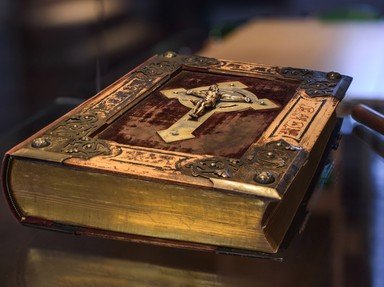Quiz Answer Key and Fun Facts
1. In Genesis 1:21, it says that God created sea creatures; the Hebrew word is "tanninim", which might indicate sea dragons or dinosaurs, though some, such as the King James Version, translate it as "whales".
2. Genesis 3 discusses which trickster that was PERHAPS a dinosaur?
3. Isaiah 14:29 in the New American Standard translation states, "Do not rejoice, Philistia, all of you, Because the rod that struck you is broken; For from the serpent's root a viper will come out, And its fruit will be a winged serpent."
Some creationists believe that the winged serpent (dragon) could have been a type of dinosaur.
What were the snakes and dragons symbolic of?
4. "Nebuchadnezzar king of Babylon has devoured me and crushed me,
He has set me down like an empty vessel;
He has swallowed me like a ____,
He has filled his stomach with my delicacies;
He has washed me away.
"May the violence done to me and to my flesh be upon Babylon,"
The inhabitant of Zion will say;
And, "May my blood be upon the inhabitants of Chaldea,"
Jerusalem will say.
Jeremiah 51:34-35, New American Standard Bible
What type of dinosaur goes into the blank?
5. According to the book of Jonah from the New American Standard Bible and many other translations, a sea-dwelling dinosaur-like monster swallowed Jonah.
6. The Behemoth, in contrast to the fearsome dragons that the Bible frequently mentions, is a possible dinosaur and a gentle giant.
While many scholars interpret it to be a hippo or some other mammal, young earth creationists consider it to be a sauropod (long-neck dinosaur).
Which book discusses Behemoth?
7. Most of the creatures that creationists believe were dinosaurs are called "dragons" in Scripture. Isaiah 51:9-11 mention what seems to be a female dragon, even if she is symbolic of Egypt.
What is the name of the dragon? She shares it with a righteous prostitute from the book of Joshua.
8. Ezekiel 32: 1-2 in the New American Standard translation states, "In the twelfth year, in the twelfth month, on the first of the month, the word of the Lord came to me saying, "Son of man, take up a lamentation over ___ king of ___ and say to him,
'You compared yourself to a young lion of the nations,
Yet you are like the monster in the seas;
And you burst forth in your rivers
And muddied the waters with your feet
And fouled their rivers.'"
I must stress that translations of this verse vary greatly. Some actually say "whale", some say "dragon", and still others say "crocodile".
Who is the king though?
9. "Praise the Lord from the earth,
Sea monsters and all deeps; Fire and hail, snow and clouds;
Stormy wind, fulfilling His word; Mountains and all hills;
Fruit trees and all cedars; Beasts and all cattle;
Creeping things and winged fowl; Kings of the earth and all peoples;
Princes and all judges of the earth; Both young men and virgins;
Old men and children" New American Standard translation
The sea monsters could be dinosaurs. Other translations say "dragons", but some say "sea creatures".
Which book of the Bible includes this poem about praising the Lord?
10. If there is any animal in the Bible that resembles not simply a dinosaur, but a fire-breathing dragon no less, it would be the one from the following verses:
"His strong scales are his pride,
Shut up as with a tight seal.
"One is so near to another
That no air can come between them.
"They are joined one to another;
They clasp each other and cannot be separated.
"His sneezes flash forth light,
And his eyes are like the eyelids of the morning.
"Out of his mouth go burning torches;
Sparks of fire leap forth.
"Out of his nostrils smoke goes forth
As from a boiling pot and burning rushes.
"His breath kindles coals,
And a flame goes forth from his mouth,"
Job 41:15-21, New American Standard translation.
Isaiah calls him a dragon of the sea. According to the Old Testament, what is his name?
Source: Author
Ceduh
This quiz was reviewed by FunTrivia editor
looney_tunes before going online.
Any errors found in FunTrivia content are routinely corrected through our feedback system.
